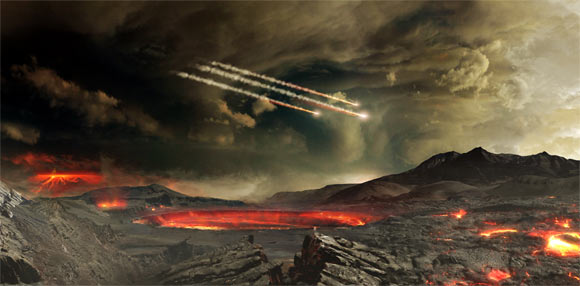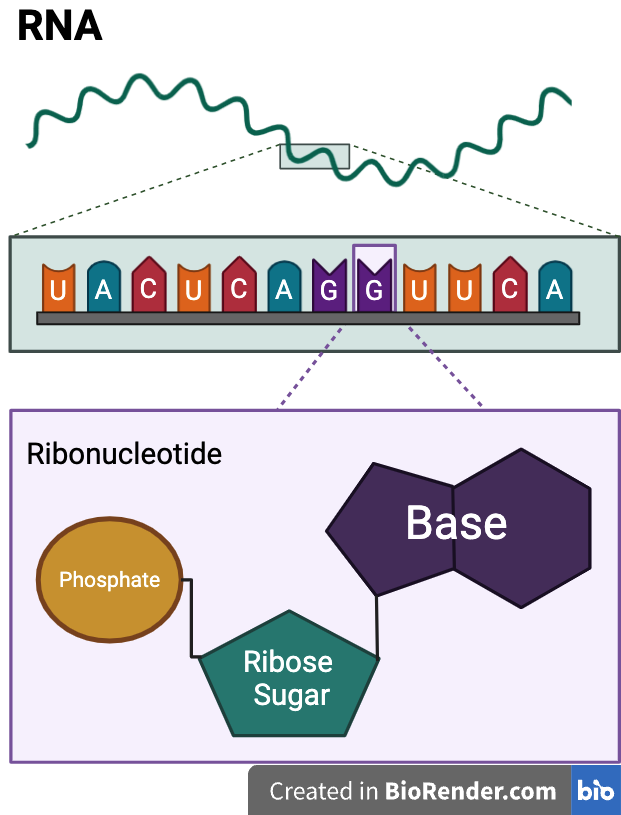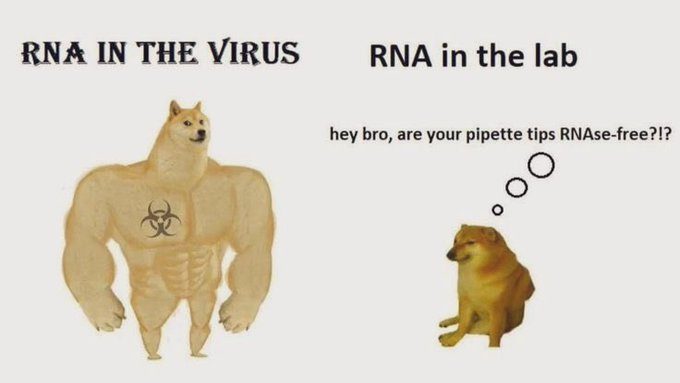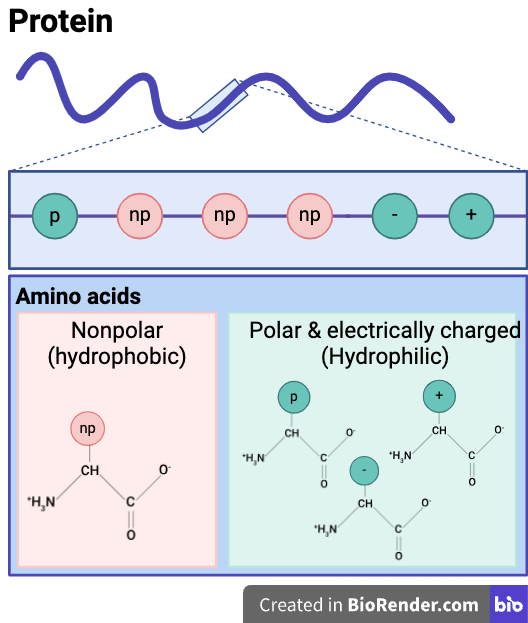 May
23
May
23
Tags
The Primordial Puzzle
The Debate Surrounding Life’s First Molecule
Few questions are more basic and more human than wondering how we came to exist. How did life arise from nonliving matter to produce the extraordinary diversity of nature: the colors in the flowers, the sophisticated ecosystems, the complexity of the brain, and its ability to hold our thoughts and feelings and enable us to ask these questions in the first place?
It has long been thought that some original molecular ancestor evolved into all of life, but the identity of this molecule is the subject of much debate. The early earth would have contained bodies of water mixed with organic compounds, cutely referred to as the “primordial soup”, (primordial meaning existing at or from the beginning of time) with conditions primed to compose a life-initiating-molecule through random chemical reactions [1,2]. In addition to being able to be formed in these early earth conditions, this molecule must have had two essential abilities to evolve: 1) the ability to store information and 2) the ability to replicate itself. Two promising molecules fit the bill: RNA and proteins.
The RNA World Hypothesis
RNA, or ribonucleic acid, is a well-established candidate for this first molecule of life. It is a nucleic acid, part of the same molecular family as DNA. RNA is best known in modern cells for acting as a translator between the DNA code (that stores information) and proteins (that serve most cellular functions including composing structure and catalyzing reactions). RNA and DNA share similar structures and information storage strategies. A single unit of RNA, or ribonucleotide, is composed of a ribose sugar, a phosphate group, and most importantly, one of four bases, A, U, C, and G (adenine, uracil, cytosine, and guanine). Like DNA, RNA stores information by linking these ribonucleotides together into long chains that serve as a molecular code.
In the 1960s, RNA, which was known to have this information storage capacity, was initially proposed by scientists to be the first molecule of life. This proposal was further strengthened by the surprising discovery of ribozymes, RNA capable of catalyzing (or kick-starting) chemical reactions, in the 1980s. This finding suggested that RNA could meet the other essential ability to evolve: self-replication. This theory was officially coined the RNA World hypothesis: that all of life began with a single RNA molecule capable of replicating itself [3]. The capacity of RNA to self-replicate has been confirmed by scientists by evolving and engineering a ribozyme capable of producing other ribozymes in 2011 [4]. Additionally, our modern cellular system contains relics of an RNA-directed replication system. The ribosome found in the cells of all living things today uses RNA to direct the formation of proteins based on RNA messengers, and it is possible that early ribosomes were composed entirely of RNA.
The last, and perhaps most essential, question that must be answered for RNA to be classified as the first molecule of life is: could it have spontaneously arisen under early earth conditions? The early Earth would have had an atmosphere primarily composed of N2 and CO2 and bodies of water on its surface full of minerals and chemicals. The ancient planet was highly reactive, with volcanic eruptions, impact events, hydrothermal vents, and atmospheric chemical reactions. These events, combined with the seasons and the shifts between day and night, would have produced consistent alterations between wet and dry, hot and cold. These conditions are perfect for chemical crystallization. Dr. Thomas Carell, an organic chemist, asked whether these conditions could be replicated in the lab to generate ribonucleotides (the individual units of RNA) [5,6]. Using basic ingredients including water and nitrogen and by cycling through wet and dry conditions, he was able to perform reactions that formed both types of ribonucleotide bases: purines (A and G) and pyrimidines (C and U). This finding indicates the plausibility of the production of RNA from nonliving matter on our ancient planet.
Were Proteins Overlooked?
RNA, while promising, is not the only life-originating molecule up for consideration. In fact, there are a few complications to the RNA World theory. RNA is a highly complex and sensitive molecule—it is unstable in a test tube sitting on a researcher’s laboratory bench, so for many scientists, it is difficult to believe that it could have survived and maintained its albeit relatively simple catalytic abilities in the changing temperatures and conditions of the early earth [7].
Another candidate has risen to challenge RNA as the potential life-originating molecule: proteins. Proteins are composed of individual amino acids, which contain conserved structures with a variety of different “side chains”. These side chains are grouped into two categories that influence how they interact with the surrounding environment, polar and electrically charged (water-loving or hydrophilic) and nonpolar (water-hating or hydrophobic). The order of amino acids containing different side chains can store information similarly to nucleotides and participate in diverse chemical reactions. In 2017, scientists Guseva, Zuckermann, and Dill generated a simple computational model displaying the potential for early proteins (which they call prebiotic polymers) to grow and create longer and different sequences through folding and clumping as a way to facilitate these chemical reactions. Their model simplified the amino acids into their two classes, polar and nonpolar, represented by colored beads. They saw that some random sequences of polar and nonpolar beads were able to collapse into compact structures, called foldamers, with the hydrophobic beads clumping together to avoid the surrounding water, and that these could elongate into other chains [9]. These random chemical polymerizations could have formed the longer protein sequences necessary to catalyze more complex reactions. This research shows that there may not have been a direct replication process, but a more archaic one where globs of proteins come together and fuse to create larger and more complex structures that are eventually capable of other functions. RNA could have arisen later and won out as the better information storage system since it is better at self-replication and would be favored eventually by natural selection.
This model provides proof of concept, but it requires lab experiments to solidify it as a theory. However, considering proteins as life-originating molecules does pose a captivating avenue of research, challenging the traditional RNA-centric view and expanding our understanding of early chemical evolution.
Why not both?
The modern cellular replication machinery relies on both RNA and protein sequences, and several scientists have more recently posited that the original molecules of life could have also been RNA-protein hybrids. In addition to the ingredients for RNAs, the world before life would have contained other organic molecules including amino acids. It is possible that early protoRNAs interacted with these amino acid components and eventually became capable of polymerizing them. Dr. Carell explains that RNA could have interacted with amino acid sequences, folding into its grooves, and eventually gaining the ability to recognize specific sequences. These combinations of RNA and protein could also eventually gain the catalytic abilities necessary for replication and continued evolution [10]. Other scientists agree that if RNA and protein origins are linked, it is very likely to evolve quickly. These proto-organisms, composed of RNA and proteins, would have followed two paths: those containing their own replication machinery (cells), and those that borrowed the replication machinery of others (viruses) [11].
Our molecular ancestor, still undercover
It is difficult to say if we will ever know for certain the molecules and events that began life here on Earth, but researchers are exploring many possible explanations. It is even possible that the first molecules, or at least their ingredients, arrived from meteorites [12]. Could we be the descendants of alien life? For now, it seems anything is possible.

References
- https://www.quantamagazine.org/videos/how-did-life-begin-on-earth/
- https://link.springer.com/referenceworkentry/10.1007/978-3-662-44185-5_1275#:~:text=The%20primordial%20soup%20is%20a,some%20have%20assumed%20that%20the
- https://www.ncbi.nlm.nih.gov/pmc/articles/PMC3331698/
- https://www.science.org/doi/full/10.1126/science.1200752
- https://www.science.org/doi/10.1126/science.aax2747
- https://www.nature.com/articles/d41586-019-02622-4
- https://www.biotechniques.com/molecular-biology/saying-goodbye-to-the-rna-world-theory/
- https://www.scientificamerican.com/article/life-rsquo-s-first-molecule-was-protein-not-rna-new-model-suggests/#:~:text=Life%27s%20First%20Molecule%20Was%20Protein%2C%20Not%20RNA%2C%20New%20Model%20Suggests,-The%20findings%20add&text=From%20Quanta%20Magazine%20
- https://www.pnas.org/doi/full/10.1073/pnas.1620179114
- https://www.nature.com/articles/d41586-022-01303-z
- https://www.ncbi.nlm.nih.gov/pmc/articles/PMC9528728/
- https://www.astronomy.com/science/comets-and-meteorites-could-have-delivered-ingredients-for-life-to-early-earth/
Images:





You must be logged in to post a comment.